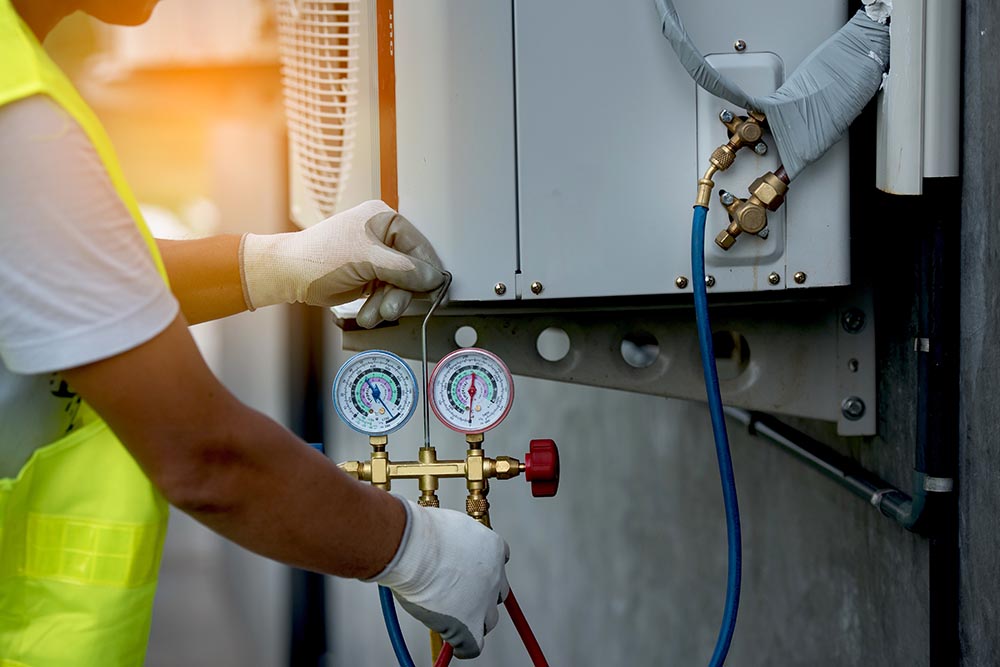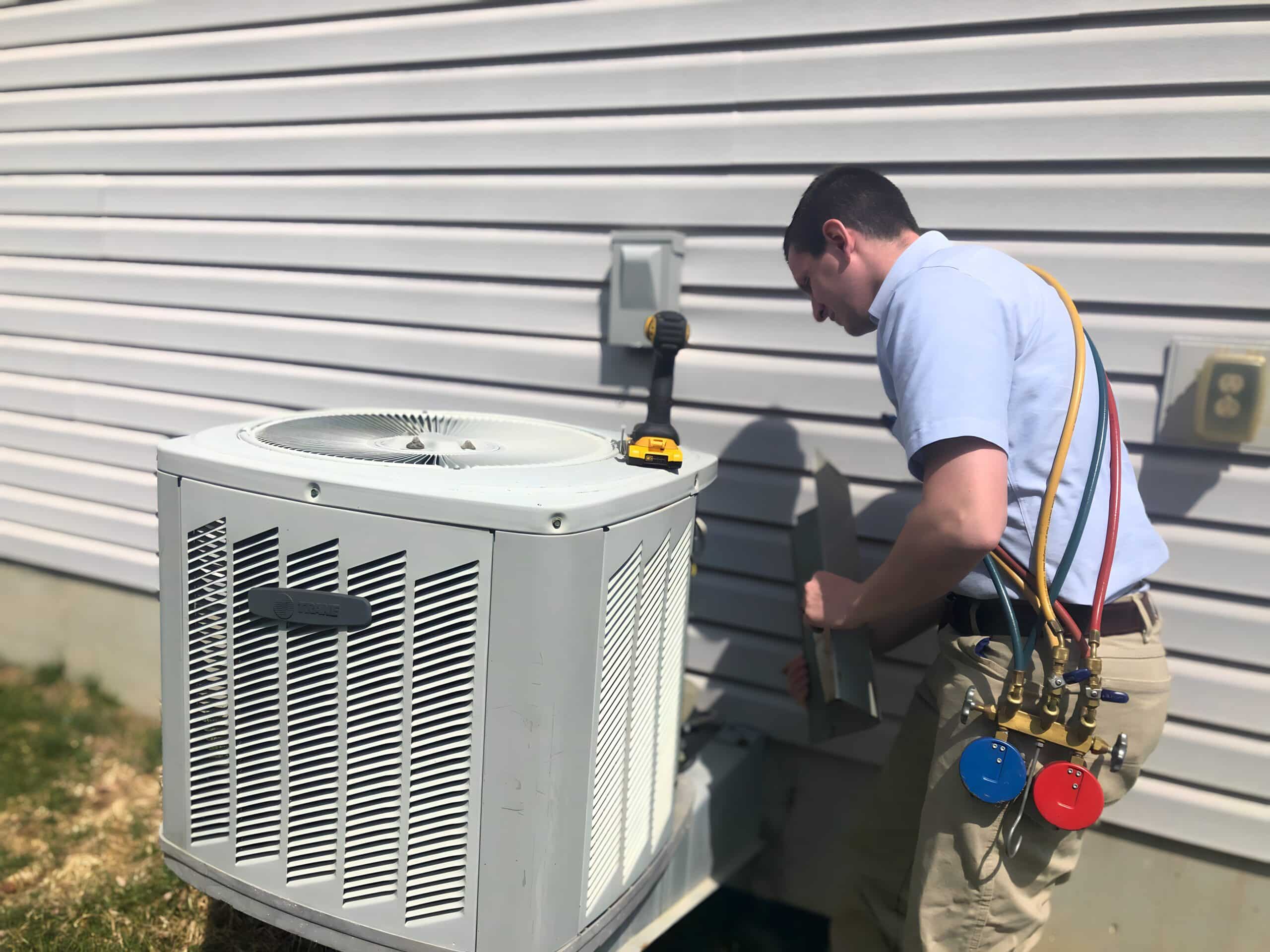Just How a Heatpump and Heater Interact to Enhance Your Home's Home heating Performance
Understanding just how a heatpump and heating system interact is essential for home owners looking for efficient heating options. Each system has its staminas, supplying a well balanced strategy to home convenience. The heatpump masters moderate temperature levels, while the furnace delivers rapid heat during severe cold. This synergy not only minimizes power expenses but also improves the life expectancy of both home appliances. What aspects affect this collaboration, and exactly how can homeowners maximize their advantages?
Recognizing Warmth Pumps: Exactly How They Work
Numerous individuals may be unfamiliar with their internal workings, warm pumps play a vital role in modern-day heating systems. These gadgets operate by transferring warm from one place to an additional, using the concepts of thermodynamics. In colder months, a heatpump extracts warm from the outside air, ground, or water, and transfers it indoors to heat the home. Conversely, throughout warmer months, it can turn around the procedure, serving as an ac system by expelling heat from inside to the outside.Heat pumps include an evaporator, condenser, compressor, and growth shutoff. The refrigerant within the system absorbs warmth as it evaporates at low temperatures and stress. The compressor after that enhances the stress and temperature level of the cooling agent, allowing it to release heat as it condenses. This effective process can significantly reduce energy intake contrasted to conventional home heating approaches, making heat pumps a lasting choice for climate control in homes.
The Role of Heaters in Home Heating
Heating systems play an essential role in home heating by giving a reputable resource of heat during the colder months. They operate by producing warmth via burning or electrical resistance, distributing it throughout the home by means of ducts or radiant systems. The performance of a heater is frequently measured by its Annual Fuel Use Effectiveness (AFUE) score, which suggests exactly how efficiently the system converts fuel right into heat.Furnaces can use different energy sources, including all-natural gas, electrical power, propane, or oil, enabling house owners to select the most appropriate choice for their requirements. Unlike heatpump, which may battle in severe cold, heating systems keep regular efficiency, guaranteeing that interior temperature levels stay comfortable despite exterior conditions. In addition, contemporary furnaces frequently come equipped with innovative technology, such as variable-speed blowers and smart thermostats, enhancing their effectiveness and responsiveness. This convenience makes heaters an essential component in all-encompassing home heating approaches.

Advantages of Utilizing Both Equipments Together
Combining the staminas of both furnaces and warmth pumps can result in an extra reliable and effective home heating solution. Using both systems permits house owners to make use of the warm pump's power efficiency throughout milder temperature levels while relying on the heating system for even more extreme cold conditions. This twin approach can substantially reduce energy prices, as heatpump consume much less electrical power than typical heating techniques when temperatures are moderate.Additionally, utilizing both systems with each other can enhance convenience levels in the home. Warm pumps can give consistent, even heating, while heaters can promptly raise ambient temperatures when required. Furthermore, the combination of both systems can prolong the life-span of tools by reducing deterioration on each system, as they share the workload. Inevitably, home owners can enjoy a balanced, cost-effective heating solution that adjusts seamlessly to varying climate condition, making sure a cozy and welcoming home throughout the winter season.
How Heat Pumps and Furnaces Complement Each Other
When house owners incorporate warmth pumps and heaters, they create a complementary heater that maximizes efficiency and convenience. Warm pumps operate by moving heat from the outdoors air or ground, making them extremely efficient in modest climates. They succeed during milder temperatures, supplying affordable heating. Alternatively, heating systems generate warm through burning or electric resistance, providing solid, instant heat during severe cold conditions.The combination of these 2 systems enables vibrant adjustments based upon temperature level changes. Throughout warmer months or milder winter season days, the warmth pump can take the lead, conserving power and decreasing prices. As temperatures decrease, the heater can perfectly involve, guaranteeing constant heat throughout the home. This synergy not only maximizes power use however additionally enhances the life-span of both systems, as each unit runs within its perfect efficiency variety. With each other, they create a well balanced environment that adapts to differing climate demands.
Maximizing Efficiency: Tips for Homeowners
Home owners can enhance their heating efficiency through numerous practical strategies. Establishing a routine maintenance routine, incorporating clever you could try here thermostat modern technology, and executing efficient insulation and sealing services are crucial actions. These procedures not just boost convenience yet also decrease energy costs.
Regular Upkeep Schedule
To ensure optimal home heating efficiency, establishing a routine upkeep timetable is important for any home. Home owners ought to prioritize regular inspections of both heatpump and furnaces to ascertain peak efficiency. This consists of altering air filters every one to 3 months, as clogged up filters can substantially lower performance. In addition, scheduling professional upkeep at the very least when a year allows specialists to identify and attend to potential concerns before they intensify. Homeowners ought to likewise clean the heatpump's outside unit to stop particles buildup that can prevent airflow. By sticking to a normal maintenance schedule, house owners not only improve their heating unit' effectiveness but likewise expand their life expectancy, leading to higher convenience and decreased power costs throughout the chillier months.
Smart Thermostat Assimilation
Integrating a smart thermostat into a home heating unit can significantly improve energy effectiveness, particularly as it enables accurate control over temperature settings. These devices can find out the homeowner's timetable and choices, immediately changing the temperature to optimize comfort while minimizing energy usage. They can reduce heating during times when the home is unoccupied, reducing unneeded usage. Lots of smart thermostats also give real-time power usage information, making it possible for home owners to make enlightened decisions about their home heating practices. Additionally, remote accessibility by means of mobile phone apps permits users to readjust settings from anywhere, guaranteeing the home is cozy upon return. Generally, smart thermostat assimilation not just improves convenience however substantially adds to energy cost savings and efficiency.
Insulation and Securing Solutions
Smart thermostats play a vital role in power efficiency, yet their effectiveness can be substantially improved by proper insulation and securing solutions. House owners must prioritize shielding attic rooms, floors, and wall surfaces to lessen warm loss. Top notch insulation materials, such as spray foam or fiberglass, can considerably boost thermal resistance. Additionally, sealing voids around ducts, doors, and windows avoids chilly air seepage and warmth retreat. Weatherstripping and caulking are effective techniques for resolving these leaks - heat pump replacement ooltewah tn. Normal inspections for air leaks, along with the use of blower door tests, can help identify problem areas. By spending in insulation and securing, home owners can maximize the efficiency of their heating unit, inevitably bring about reduced energy consumption and lower energy expenses
Common Myths Concerning Heat Pumps and Furnaces
What false impressions border warm pumps and heating systems? Numerous individuals wrongly believe that heat pumps are inadequate in chillier climates. Actually, modern-day warmth pumps are created to operate efficiently also in low temperatures, providing reputable heating throughout winter. An additional typical misconception is that heating systems are always extra effective than heat pumps. Nonetheless, this helpful site relies on the details power sources and efficiency scores of the units concerned. Some might likewise assume that using both systems simultaneously is unneeded, but actually, this mix can enhance home heating effectiveness, especially throughout extreme climate condition. In addition, people usually presume that heatpump require consistent upkeep, when actually, they have comparable maintenance needs to conventional heater. By exposing these myths, home owners can make more enlightened choices regarding their heating alternatives, ultimately causing boosted comfort and energy effectiveness in their homes.
Upkeep Factors To Consider for Combined Systems

Regularly Asked Inquiries
Can Warmth Pumps Job Properly in Extremely Cold Climates?
Heat pumps can battle in exceptionally cool environments because of decreased efficiency and heat extraction constraints. Advancements in innovation have led to models designed for much better efficiency in such problems, boosting their viability in harsh environments.
For How Long Do Warmth Pumps and Furnaces Commonly Last?
Warm pumps typically last 15 to 20 years, while heaters have a life-span of 15 to 30 years. Normal maintenance can expand their durability, ensuring effective procedure and decreasing the demand for premature substitutes.

What Is the Ordinary Expense of Installing Both Equipments?
The average price of setting up both a heatpump and a heater commonly varies between $5,000 to $10,000 - ductless mini splits. Variables influencing this price consist of system size, installation intricacy, and regional labor prices
Are There Tax Motivations for Utilizing Energy-Efficient Home Heating Equipments?
Numerous homeowners make inquiries about tax rewards for energy-efficient furnace. Different government and state programs typically supply refunds or credit ratings, motivating the fostering of lasting technologies to minimize power consumption and promote environmental duty.
Exactly how Do I Pick the Right Dimension Warmth Pump and Furnace?
Selecting the ideal dimension heatpump and furnace includes determining the home's square video, taking into consideration insulation quality, and assessing regional climate. Consulting an expert can ensure suitable system efficiency and power effectiveness based upon certain requirements. furnace replacement. Comprehending exactly how a warm pump and heating system job together is necessary for home owners looking for effective heating solutions. In cooler months, a warmth pump essences heat from the outside air, ground, or water, and transfers it inside to warm up the living area. When property owners integrate warmth pumps and heaters, they produce a complementary home heating system that makes the most of performance and convenience. Heat pumps run by moving heat from the outdoors air or ground, making them very effective in moderate environments. Warmth pumps can have a hard time in incredibly cold environments due to decreased efficiency and warm extraction limitations
Comments on “A Step-by-Step Walkthrough to heat pump replacement ooltewah tn”